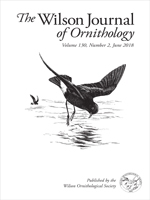Tropical dry forest is one of the most threatened ecosystems in the Neotropics as a result of agriculture, cattle ranching, and timber extraction. The effects of disturbance on the bird communities of this ecosystem have not been well studied. In this study, we evaluated changes in the richness, abundance, and diversity of birds and their diet types in the following land uses in southwestern Mexico: agroecosystem, palm grove, forest edge, and undisturbed forest. Visual and auditory sampling was performed for 1 year (August 2014 to July 2015) in 40 circular plots with a radius of 30 m (10 plots per land use). Differences in the composition and the abundance of bird species in plots of distinct land use were analyzed by a non-metric multidimensional scaling (NMDS) ordination to determine similarity among the data. In total, 101 species from 29 families were found in the study sites. The agroecosystem presented the greatest species richness (70 species), followed by undisturbed forest (57). Overall abundance of birds differed significantly among land uses. Bird abundance and dominance, in addition to the abundance of diet types, also varied significantly among land uses and between dry and rainy seasons. We found species of open habitats as well as species dependent on undisturbed forest fragments. The results suggest that seasonal variation in the abundance of birds is mainly determined by the availability of food resources and other local environmental factors. The abundance of carnivorous, granivorous, omnivorous, insectivorous, and frugivorous birds was higher at disturbed sites while the abundance of nectarivorous birds was higher in the undisturbed forest. The species composition of the undisturbed forest was most distinct among the land uses. Our results showed that the comparison of diet types was more useful for understanding the effect of land-use changes than the sole evaluation of the structural patterns of bird assemblages.
How to translate text using browser tools
1 June 2018
Spatiotemporal variation in the structure and diet types of bird assemblages in tropical dry forest in southwestern Mexico
Edson A. Alvarez-Alvarez,
Pablo Corcuera,
R. Carlos Almazán-Núñez
ACCESS THE FULL ARTICLE

The Wilson Journal of Ornithology
Vol. 130 • No. 2
June 2018
Vol. 130 • No. 2
June 2018
abundance
agroecosystem
bird richness
disturbance
land uses
tropical dry forest
undisturbed forest




